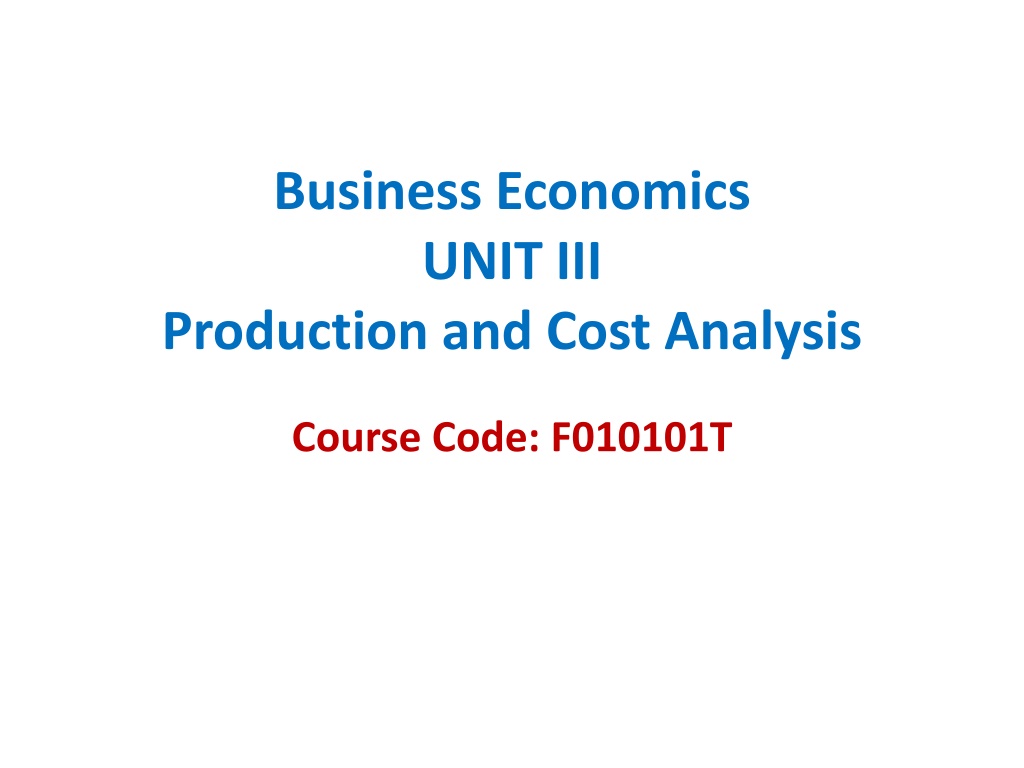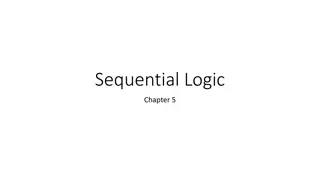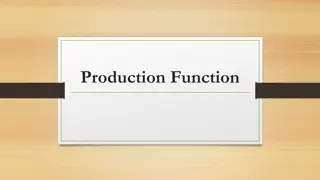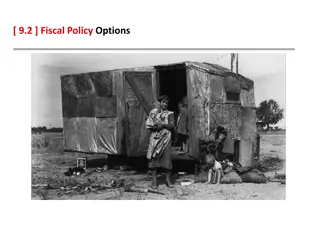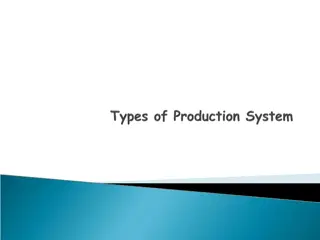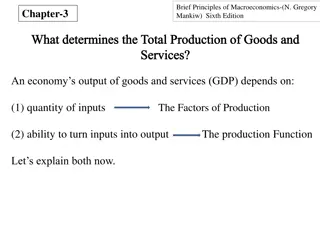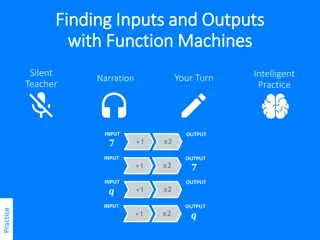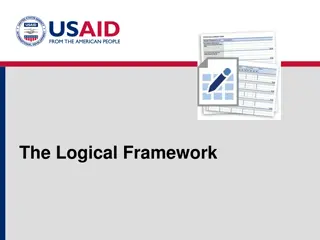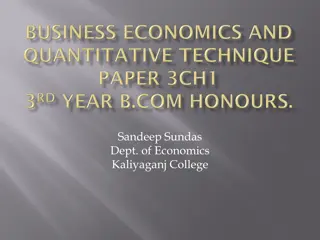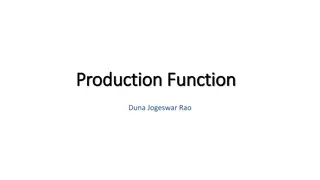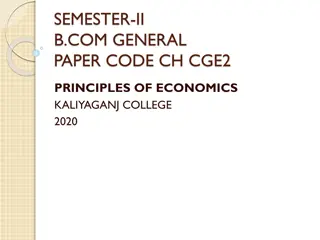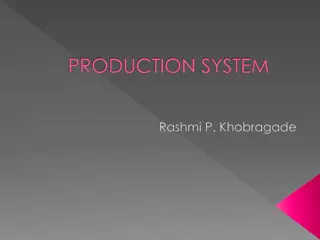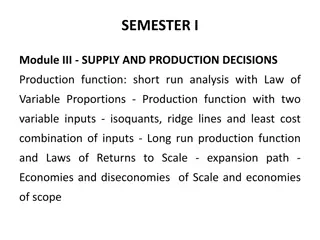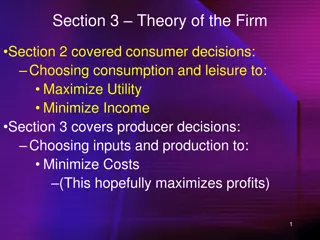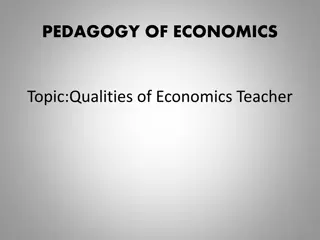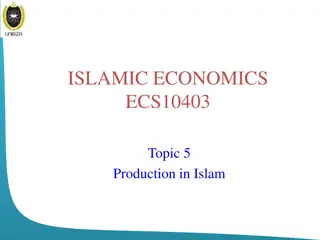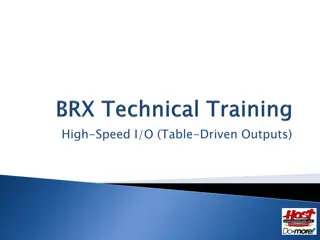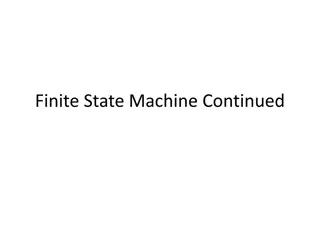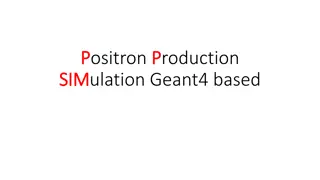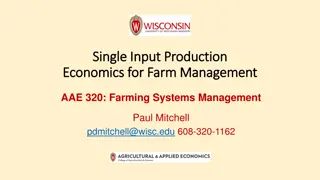Production Function in Economics: Inputs and Outputs Relationship
A production function in economics illustrates the correlation between inputs and outputs in the production process. It showcases how various factors like labor, capital, and technology impact overall output levels. Key concepts include Total Product (TP), Marginal Product (MP), and Average Product (AP). Production functions aid in maximizing output and analyzing technological advancements' effects on production processes.
Download Presentation

Please find below an Image/Link to download the presentation.
The content on the website is provided AS IS for your information and personal use only. It may not be sold, licensed, or shared on other websites without obtaining consent from the author. Download presentation by click this link. If you encounter any issues during the download, it is possible that the publisher has removed the file from their server.
E N D
Presentation Transcript
Business Economics UNIT III Production and Cost Analysis Course Code: F010101T
Production Function A production function is a fundamental concept in economics that represents the relationship between inputs (factors of production) and outputs (goods and services) in the process of producing goods and services. It provides a mathematical or graphical representation of how different combinations of inputs lead to different levels of output.
Production Function Q = f(L, K, M, ...) Where: Q represents the quantity of output produced. L stands for labor input. K represents capital input (physical capital such as machinery, equipment, etc.). M could represent other inputs such as materials, technology, or land. ... indicates that there can be more inputs.
Production Function The production function shows how varying the quantities of inputs affects the resulting output. It helps economists and businesses analyze how factors like labor, capital, and technology contribute to production and how changes in these factors influence overall output levels.
Production Function There are several key concepts related to production functions: 1. Total Product (TP): This refers to the total quantity of output that is produced from a given combination of inputs. 2. Marginal Product (MP): The marginal product of a specific input is the additional output produced by adding one more unit of that input while keeping other inputs constant. 3. Average Product (AP): The average product of a specific input is the total output divided by the quantity of that input.
Production Function Production functions are used in various economic analyses, such as determining combination of inputs to maximize output or analyzing the effects of technological advancements on production processes. the optimal
Law of variable proportion known as the Law of Diminishing Return That describes the relationship between the variable inputs (such as labor or raw materials) and the output of a production process. It explains how changes in the proportion of one input while keeping other inputs constant can affect the overall production.
Law of variable proportion The Law of variable proportion states that when only one production element is allowed to increase keeping all other elements constant, the production firstly increases, then the output will decrease and finally there will be a negative production.
Law of variable proportion The law states that as more units of a variable input are added to a fixed quantity of other inputs (like capital and land), there comes a point where the marginal product of the variable input starts to decrease. In simpler terms, initially, increasing the variable input leads to a more than proportional increase in output, but eventually, the additional input leads to smaller and smaller increases in output or even negative effects on output.
Assumptions 1. Constant state of Technology: It is assumed that the state of technology will be constant and with improvements in the technology, the production will improve. 2. Variable Factor Proportions: This assumes that factors of production are variable. The law is not valid, if factors of production are fixed. 3. Homogeneous factor units: This assumes that all the units produced are identical in quality, quantity and price. homogeneous in nature. In other words, the units are 4. Short Run: This assumes that this law is applicable for those systems that are operating for a short term, where it is not possible to alter all factor inputs.
Example Imagine a fixed plot of land (the fixed input) and labor as the variable input. Initially, adding more laborers to work on the land could lead to increased productivity. However, as the number of laborers increases further, they might start getting in each other's way, causing inefficiencies, and the additional output gained from each new laborer might decrease. Eventually, adding even more laborers could lead to a situation where the land becomes overcrowded, resulting in a decline in overall output.
COST OF PRODUCTION The total cost incurred by a business to produce a specific quantity of a product or offer a service. The expenditures incurred to obtain the factors of production such as labor, land, and capital, that are needed in the production process of a product.
Explicit Cost Explicit Costs refer to the actual expenditures of the firm to hire, rent or purchase the input it requires in production. These include the wages to hire labour, the rental price of capital, equipment and buildings and the purchase prices of raw materials etc. These are the recorded expenditure during the process of production.
Implicit costs The costs of self-owned and self-employed resources. These include the rewards for the entrepreneur s self- owned land, labour and capital. These costs do not appear in the accounting records of the firm. The sum of explicit costs and implicit costs constitutes the total cost of production of a commodity.
Implicit Cost Implicit costs include the highest salary that the entrepreneur can earn for him, if working for other firms and the highest return the firm could receive from investing its capital in alternatives uses or renting its land and buildings to the highest bidder rather than using them itself.
Economic Cost Economic Cost = Accounting cost (Explicit Costs) + Implicit Cost (including normal profit)
Normal Profit The minimum payment which a producer must get in order to induce him to undertake the risk Involved in production. Reward entrepreneurs. or remuneration for the services of the It is part of the cost of production because unless the entrepreneur expects to get it in the long-run, he is not likely to undertake production. From an economic perspective, normal profit is also a type of cost. It represents the cost needed to keep the firm in business.
Economic cost Is the sum total of both explicit cost and implicit cost, including normal profit, Economic cost is wider than the accounting cost. It includes both explicit cost and implicit cost (including normal profit), whereas accounting cost includes only explicit or money cost. In the theory of price, cost is taken in the sense of economic cost.
Real Cost and Nominal Cost A nominal cost, also known as a nominal price, is the current price or cost of a good or service without adjusting for inflation or changes in purchasing power. In other words, it's the price that is expressed in the currency of the given time period without considering the impact of changes in the value of money over time.
Nominal Cost if the price of a product increases from RS. 100 to Rs. 120 over the course of a few years, you might think the nominal cost has gone up by Rs. 20. However, if inflation during that time was 10%, the real increase in cost (adjusted for inflation) would only be Rs. 10 in terms of purchasing power.
Real Cost if the price of a product increases from Rs.100 to Rs.120 over the course of a few years, you might think the nominal cost has gone up by Rs.20. However, if inflation during that time was 10%, the real increase in cost (adjusted for inflation) would only be Rs.10 in terms of purchasing power.
Real Cost For example, if a product's nominal cost increased from Rs.100 to Rs.120 over a certain period, and the inflation rate during that time was 10%, the real cost of the product would be: Real Cost = Nominal Cost / (1 + Inflation Rate) Real Cost = Rs.120 / (1 + 0.10) Real Cost Rs.109.09
Replacement Cost Replacement cost is a financial concept that refers to the expense required to replace an asset, such as a piece of equipment, a building, or an entire business, with a new one of the same kind and quality. It represents the amount of money needed to reproduce or replace an asset at its current market value, without factoring in depreciation.
Historic Cost Historic costs are incurred at the time of purchase of assets. They are also regarded as sunk costs, as they cannot be retrieved from the business without loss. Sunk cost is an economic term for a sum paid in the past, which should no longer be relevant; hence these costs are irrelevant in decision-making with the perspective of time.
Controllable and Uncontrollable Costs Controllable costs are those which are subject to regulation by the management of a firm, example, fringe benefits to employees, costs of quality control, etc. On the other hand, uncontrollable costs are beyond regulation of the management example, minimum wages to be paid are determined by government, price of raw material by supplier.
Production and Selling Costs Production costs (or simply costs) are estimated as a function of the level of output, whereas selling costs are incurred on making the output available to the consumer. A commission paid to the salesman is calculated on the value of sales and is a selling cost whereas cost of raw material is a production cost.
Social Cost The cost that the society has to hear on account of the production of a commodity.
Social Cost For instance, oil refinery may discharge its wastes in the river causing water pollution; mills and factories located in the city cause air pollution by emitting smoke; buses and trucks and other vehicles cause both air and noise pollution. Such water, air and noise pollution cause health hazards and thereby involve cost to the entire society.
Opportunity Cost Opportunity cost of a decision may be defined as the cost of next best alternative sacrificed in order to take this decision. In short, the opportunity cost of using resources to produce a good is the value of the best alternative or opportunity forgone. Opportunity costs include both explicit and implicit costs. For example, if with a sum of Rs. 2000, a producer can produce a bicycle or a radio set and decides to produce a radio set. In this case, opportunity cost of a radio set is equal to the cost of a bicycle that he has sacrificed.
Short Run Costs and Long Run Costs Short run is a period of time within which the firm can change its output by changing only the amount of variable factors, such as labour and raw materials etc. In short period, fixed factors such as land, machinery etc, cannot be changed. Costs of production incurred in the short run i.e., on variable factors are called short run costs. The long run costs are the costs over a period in which all factors are changeable.
Fixed and Variable Cost Fixed cost includes expenses that remain constant for a period of time irrespective of the level of outputs, like rent, salaries, and loan payments, while variable costs are expenses that change directly and proportionally to the changes in business activity level or volume, like direct labor, taxes, and operational expenses.
Fixed Costs The expenses incurred on fixed factors are called fixed costs, whereas those incurred on the variable factors may be called variable costs. The fixed costs include the costs of: (a) The salaries and other expenses of administrative staff; (b) The salaries of staff involved directly in the production, but on a fixed term basis; (c) The wear and tear of machinery (standard depreciation allowances); (d) The expenses for maintenance of buildings; (e) The expenses for the maintenance of the land on which the plant is installed and operates and (f) Normal profit, which is a lump sum including a percentage return on fixed capital and allowance for risk.
Variable cost The variable costs include the cost of: (a) Direct labour, which varies with output. (b) Raw materials; and The sum of fixed and variable costs constitutes the total cost of production. Symbolically, TC = TFC + TVC
Semi Variable Cost This type of cost lies in between fixed and variable cost. It is neither perfectly variable nor perfectly fixed in relation to changes in output. This type of costs include a portion of fixed cost and a portion of variable cost, this is known as semi variable cost. For example- electricity bill generally include both a fixed charge (meter rent) and a variable charge(charge based on units consumed) and the total payment made is semi variable cost.
Total variable costs (TVC) On the other hand, are the total obligations of the firm per time period for all the variable inputs that the firm use. Variable inputs are those that the firm can change easily and on short notice. Payment for raw materials the labour costs, excise duties are included invariable costs.
Total Costs Total costs (TC) equal total fixed costs (TFC) plus total variable costs (TVC). That is TC = TFC + TVC.
Total Fixed Cost (TFC) Total fixed cost is the sum of expenses incurred on those inputs that remain same at different levels of output. Total fixed cost is graphically shown. It is a straight line parallel to output or x-axis. TFC is the total fixed cost curve parallel to x- axis indicating that it remains constant at all levels of output.
Total Fixed Cost (TFC) Total cost incurred by the firm on the use of all fixed factors. This cost is independent of output, it does not change with change in the quantity of output. It remains constant regardless of the quantity of output produced. Fixed cost includes interest on the capital invested, rent, insurance premium, property tax, etc. That is why fixed cost is often known as 'unavoidable cost.
Total Variable Cost (TVC) Total variable cost is the sum of expenses incurred on those factor inputs whose quantity varies with a change in the level of output. Total variable cost curve TVC is shown in the Fig. It has inverse-S shape. Total variable costs increase as the level of output increases.
Total Variable Cost (TVC) This cost includes payments for raw materials, wages paid to temporary and casual workers, payment for fuel and power used in production, etc. Since the use of variable factors varies in accordance with the level of output, variable costs also vary with the level of output. These costs vary directly with change in the volume of output; rising as more is produced and falling as less is produced.
TVC Curve Total variable cost increases with output. But the rate of increase in the total variable cost is different at different levels of output. As can be seen from the column (3) of Table 1, total variable cost initially increases at a decreasing rate as total output increases (up to 3 units) and subsequently it increases at an increasing rate with increase in output (from 4th unit onwards). The TVC curve is a positively sloping curve, showing that as output increases total variable cost also increases. But the rate of increase of TVC is not same thoughout; it increases at a decreasing rate first and then at an increasing rate. Hence, TVC curve looks like 'inverted S-shape. Also, note that TVC curve starts from the origin which shows that when output is zero, total variable cost is also zero.
TVC Curve Total variable cost increases at a diminishing rate due to increasing returns to the variable inputs arising from the fuller utilisation of fixed factors and specialisation. It increases at an increasing rate due to diminishing returns to the variable inputs arising from difficulty of management and over utilisation of fixed factor etc.
Total Cost (TC) Total cost to a producer for the various levels of output is the sum of total fixed costs and total variable costs, i.e., TC = TFC+TVC Total cost of production which is the sum of total variable cost and total fixed cost.
Total Cost Since total cost has total variable cost as one of its components which varies with change in output, the total cost will also change directly with the change in output. Also, since total fixed cost by definition remains constant, the changes in total cost are entirely due to changes in total variable cost.
TC Curve Total cost is the sum of total fixed cost and total variable cost. Since a constant fixed cost is added to the total variable cost, the shape of TC curve is the same as that of the TVC curve. This means that slopes of the total cost curves and the total variable cost curves are identical. In other words, TC curve and TVC curve are always parallel to each other. Note that TC curve originates not from O, but from point A because at zero level of output total cost equals total fixed cost since TVC is zero when output is zero. Thus, total variable cost curve starts from the origin while the total cost curve starts at the point where the total fixed cost curve intersects the vertical axis (starting point of TFC). Vertical distance between the TVC and TC curves equals the amount of total fixed cost, and since the total fixed cost is constant, the vertical distance between the TVC curve and TC curve is same at all levels of output. Like TVC, TC increases at a decreasing rate first and then at an increasing rate. Hence, the TC curve is initially concave downward, subsequently it is concave upward. This behaviour of the TC curve follows directly from the law variable proportions.
Average Cost Curves Average cost is the cost per unit of output. Average cost is simply the total cost divided by the number of units produced Corresponding to three types of total costs in the short-run, there are three types of average cost namely (1) average fixed cost, (2) average variable cost, and (3) average total cost.
